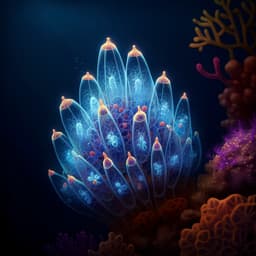
Earth Sciences
Deep sea cold seeps are a sink for mercury and source for methylmercury
J. Li, X. Dong, et al.
Discover how seafloor cold seeps could transform our understanding of mercury cycling in the ocean. This innovative research, conducted by Jiwei Li and colleagues, reveals the significant enrichment of mercury and methylmercury in active seep areas and identifies microbes that play a crucial role in their biogeochemical processes.
~3 min • Beginner • English
Introduction
Mercury (Hg) enters the ocean mainly as inorganic Hg from natural and anthropogenic sources. In aquatic systems, inorganic Hg can be converted to methylmercury (MMHg), a bioaccumulative neurotoxin that poses risks to ecosystems and human health. The ocean receives Hg via atmospheric deposition, air–sea gas exchange, rivers, submarine groundwater discharge, and hydrothermal inputs. MMHg is enriched in subsurface waters (100–1000 m), a depth range important for marine food webs, but whether the deep ocean supports Hg methylation/demethylation remains uncertain. Seafloor cold seeps host sulfate reduction, anaerobic methane oxidation, and methanogenesis, and taxa involved in these processes (e.g., sulfate-reducing bacteria, methanogens, and ANME archaea) are known Hg methylators. Thus, cold seeps may be overlooked hotspots for Hg(II) methylation and/or MMHg demethylation not represented in global Hg models. To test this, the study measured Hg and MMHg concentrations, Hg stable isotope compositions, and metagenomes from sediment cores and seep bivalves at the Haima cold seep (South China Sea), comparing active, inactive, and nearby reference areas.
Literature Review
Prior work documents global and oceanic Hg budgets and the subsurface ocean enrichment of MMHg, suggesting significant oceanic roles in Hg cycling. Studies have shown widespread microbial potential for Hg methylation in marine systems and high Hg accumulation in hadal sediments. Known Hg methylators include sulfate-reducing bacteria, methanogens, and anaerobic methane-oxidizing archaea. Isotopic approaches (MDF and MIF of Hg isotopes) can trace sources and processes, with Δ199Hg/Δ201Hg ratios differentiating photochemical pathways. However, the role of deep-sea cold seeps in Hg cycling has been largely unexamined in global models, motivating this targeted field investigation at Haima cold seep.
Methodology
Sampling: Bivalves (Gigantidas haimaensis from active seep; Calyptogena marissinica from inactive seep) and sediment push cores (A2, A3, A4 reference; B1, B2 active; C1 inactive) 14–30 cm long were collected in 2018–2019 at the Haima cold seep (South China Sea) using R/V Tansuo Yihao and submersible ShenHai YongShi. Porewater was extracted onboard using Rhizon samplers to avoid oxidation. Sediments were sectioned every 2 cm and stored at −80 °C; bivalve tissues (gill and mantle) were similarly stored.
Geochemistry: Total Hg was measured on a DMA-80 following USEPA 7473 with QA/QC using blanks, duplicates, and CRMs (ERM-CC580). Recoveries were 103%–105%; RSD <5%. MMHg in two bivalves and three cores (A2, B1, C1) was determined by KOH digestion (tissues) or CuSO4–HNO3 leaching with CH2Cl2 extraction (sediments), ethylation with NaB(C2H5)4, purge-and-trap on Tenax, and GC–CVAFS. Blanks were 0.001 ± 0.010 ng g−1; recoveries 93%–104% (ERM-CC580) and 104%–111% (DORM-4); RSD <10%.
Hg isotopes: Two bivalves and three sediment cores (A2, B1, C1) were analyzed. Tissues were digested in HNO3 at 95 °C, oxidized with BrCl, and reduced with hydroxylamine; sediments were pre-concentrated via double-stage tube furnace with reverse aqua regia traps. Solutions were analyzed on a Nu Plasma II MC-ICP-MS using NIST SRM 997 Tl for mass bias correction and NIST 3133 for bracketing. δ202Hg values were reported relative to NIST-3133; MIF (Δ199Hg, Δ200Hg, Δ201Hg) was calculated using ΔxxxHg = δxxxHg − β×δ202Hg with β of 0.2520, 0.5024, and 0.7520 for 199, 200, and 201, respectively. Analytical uncertainty was estimated as 2 SD of NIST-3177 secondary standard measured every 10 samples.
Porewater and sediment chemistry: Porewater DIC and δ13C-DIC were measured by GasBench-MAT253 after acidification and CO2 analysis; precision ±0.2‰. Sediment TOC/TN were measured by EA/IRMS; porewater sulfate by ion chromatography.
Metagenomics: DNA from B1, B2, and C1 was extracted (PowerSoil kits). Libraries were sequenced on DNBSEQ-T1 and BGISEQ500. Reads were quality-controlled with metaWRAP Read_QC; assemblies were generated individually and co-assembled using MEGAHIT (k: 21–119). Binning used metaWRAP (MetaBAT2, MaxBin2, CONCOCT); bin refinement required completeness ≥50% and contamination ≤10%. Dereplication at 95% ANI used dRep; MAG quality was assessed with CheckM; taxonomy assigned using GTDB-Tk (R06-RS202); coverage with CoverM. In total, 487 dereplicated MAGs were obtained.
Gene catalog and functional annotation: Genes were predicted with Prodigal (-p meta), clustered at 95% similarity and 90% coverage using CD-HIT to yield 6,655,350 nonredundant genes. Gene abundances were quantified with Salmon (mapping-based, --validateMappings --meta). Genes for Hg cycling (hgcAB, merB, merA) were identified via HMMs (MEHG repository). Phylogeny: protein sequences were aligned with MAFFT, trimmed with TrimAl, and ML trees built with IQ-TREE (ModelFinder; 1000 SH-aLRT bootstraps).
Key Findings
- Enrichment in active seep sediments: In the upper 0–12 cm, Hg averaged 97.2 ± 37.2 ng g−1 (n=10) in the active area, 2.3–2.4× higher than inactive (42.8 ± 4.18 ng g−1, n=6) and reference (40.4 ± 6.49 ng g−1, n=14). Below 12 cm, Hg levels were similar across areas (active 38.7 ± 5.88 ng g−1, n=12; inactive 33.5 ± 6.00 ng g−1, n=16; reference 41.1 ± 0.91 ng g−1, n=5). Core-top (0–2 cm) Hg was 164 ng g−1 in active vs 51.1 ng g−1 in reference.
- Biota Hg: G. haimaensis tissues from the active area had higher total Hg (gill 280 ng g−1; mantle 90.7 ng g−1) than C. marissinica from the inactive area (gill 68.3 ng g−1; mantle 41.5 ng g−1). MMHg in bivalves was extremely low (below detection or <1% of total Hg).
- Organic matter relations: Total Hg correlated with TOC across all cores (R2 = 0.39, p < 0.05). Hg/TOC ratios were elevated in active seep sediments, implying enhanced sorption capacity or preferential degradation of OC less strongly binding Hg.
- MMHg patterns: In 0–12 cm, MMHg averaged 0.21 ± 0.37 ng g−1 (active, n=5) and 0.21 ± 0.36 ng g−1 (inactive, n=6), both higher than reference (0.02 ± 0.01 ng g−1, n=6). MMHg and MMHg/Hg maxima co-occurred within cores, with MMHg/Hg peaks ~8× (active) and ~18× (inactive) those of the reference. In the active area, MMHg maxima coincided with the SMTZ, where sulfate was low (0.47–0.49 mM) and δ13C-DIC was strongly depleted (to −56.31‰). In the inactive area, MMHg peaks occurred at the core top, alongside very high DIC (19.1 mM) and relatively enriched δ13C-DIC (−5.95‰), consistent with intense OM degradation and dead clam inputs.
- Hg isotopes: δ202Hg in G. haimaensis was +0.32‰, similar to active core-top sediment (+0.20‰), whereas C. marissinica had −0.62‰. In active cores, δ202Hg decreased with depth (+0.20‰ to −0.72‰), as did Δ199Hg (e.g., from +0.27‰ to −0.14‰), while reference and inactive profiles lacked clear depth trends (reference Δ199Hg mean 0.07 ± 0.06‰, n=15; inactive 0.11 ± 0.05‰, n=11). The Δ199Hg/Δ201Hg slope was 1.23 ± 0.10 in active sediments, distinct from 0.96 ± 0.04 in reference/inactive. Δ200Hg values were near zero across sites (means: active 0.01 ± 0.03‰; inactive 0.03 ± 0.02‰; reference 0.02 ± 0.02‰).
- Process interpretation: The Δ199Hg/Δ201Hg slope ~1.23 in active sediments indicates abiotic dark redox reactions (nuclear volume effects) contributing to Hg transformations, beyond photochemical signatures inferred in reference/inactive areas (slope ~1.0). Surface active sediments exhibit positive MDF and odd-MIF due to deposition of upper-ocean Hg and oxidation of deep-sourced Hg0 to Hg(II); deeper active sediments shift to negative MDF and odd-MIF due to organic-matter-driven dark reduction and adsorption processes under anoxia.
- Microbial evidence: Genes for Hg cycling were abundant. hgcA abundance peaked at 37 GPM (C1, 4–6 cm) and 18 GPM (B2, 0–2 cm) with depth-dependent patterns; merB showed similar vertical trends; merA was low. From 487 MAGs, 38 putative Hg methylators (hgcA+) spanned 14 phyla (including Desulfobacterota, Chloroflexota, Halobacteriota/ANME-2, etc.), with several clades (Zixibacteria, TA06, Krumholzibacteriota, Eisenbacteria, Lokiarchaeia) newly implicated. Desulfobacterota dominated upper zones; an HR1 (ANME-2) archaeal MAG reached up to 2.9% of the community (C1) and increased with depth. Six MAGs (Chloroflexota, Planctomycetota, Gammaproteobacteria) harbored merB; one Gammaproteobacterial MAG had merA.
- Global implications: For Haima, enrichment in the active area’s upper 12 cm implies an additional 3.15 Mg Hg and 0.01 Mg MMHg preserved versus reference sediments, assuming 350 km2 active area and 1.3 g cm−3 dry bulk density. Extrapolating to ~900 global cold seeps of comparable active area yields an additional 2835 Mg Hg and 9 Mg MMHg stored. These stocks correspond to roughly 13 years (Hg, vs ~220 Mg y−1 burial) and 1 year (MMHg, vs ~9 Mg y−1 burial) of global deep-sea burial fluxes.
Discussion
The study demonstrates that active cold seeps significantly concentrate inorganic Hg in surface sediments and enhance MMHg production, addressing the open question of whether deep-sea environments can support Hg methylation/demethylation. Elevated Hg/TOC, strong correlations with TOC, and co-occurrence of MMHg and Hg/TOC maxima near the SMTZ indicate that seep-derived organic matter and redox zonation increase Hg sorption and bioavailability, fostering microbial methylation. Hg isotope systematics reveal distinct signatures at active seeps, with a Δ199Hg/Δ201Hg slope (~1.23) indicative of abiotic dark redox reactions, likely driven by abundant thiols and organic matter, superimposed on photochemical signatures inherited from upper-ocean deposition in reference/inactive sites. Vertical isotopic trends in active sediments reflect combined effects of deposition, oxidation of rising Hg0 near the sediment-water interface, and deeper anoxic dark reduction and adsorption. Metagenomics confirms a diverse suite of bacterial and archaeal Hg methylators and demethylators, including Desulfobacterota and ANME-2 archaea, supporting active microbial Hg transformations. Collectively, these findings establish cold seeps as previously unrecognized sinks for inorganic Hg and sources of MMHg in the deep ocean, with potential implications for deep-ocean Hg budgets and exposure pathways in marine food webs.
Conclusion
Active cold seep sediments at Haima are enriched in Hg and MMHg relative to nearby reference and inactive areas, exhibit distinctive Hg isotope signatures consistent with abiotic dark redox processes, and host diverse microbial communities harboring hgcA, merB, and merA genes, demonstrating active Hg cycling. Extrapolation suggests cold seeps globally store additional Hg and MMHg equivalent to multi-annual fractions of global deep-sea burial fluxes, indicating they are an overlooked component of marine Hg budgets. Future work should quantify in situ transformation and flux rates (including advective and diffusive exchange), constrain temporal variability across seep types and activity stages, expand site coverage beyond Haima, and integrate seep processes into global Hg models to refine risk assessments for deep-ocean MMHg sources.
Limitations
- Flux quantification is lacking: the study infers stocks and processes from concentration, isotope, and genomic data without direct rate measurements, and emphasizes that fluxes (Mg y−1) may be important.
- Extrapolation uncertainty: global storage estimates assume other cold seeps have active areas comparable to Haima and similar enrichments, likely under- or over-estimating true contributions.
- Spatial scope: Findings are from a single seep system (Haima) with limited cores and shallow depth intervals (top ~30 cm), which may not represent global variability across seep geologies and activities.
- Biological uptake: Very low MMHg in bivalves limits conclusions on biomagnification at seeps; food web structures may differ from typical marine systems.
- Method coverage: MMHg and isotope analyses were performed on subsets of cores and biota, which may constrain resolution of spatial heterogeneity.
Related Publications
Explore these studies to deepen your understanding of the subject.







